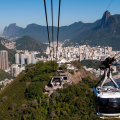PÃO DE AÇÚCAR - SUGAR LOAF
The Sugarloaf Hill and its cable car are emblematic markers of Rio and offer a breathtaking view of the bay.
It's a must-see when arriving in or returning to Rio. Along with Christ the Redeemer, Sugarloaf is one of Rio's most famous landmarks, and one of its most famous postcards. Many graphic signatures and brands (including a major retailer) use the name or image of this geological phenomenon located in the southern part of the city, near the Praia Vermelha. At a height of 395 m, Sugar Loaf stands at the entrance to Guanabara Bay. Its summit is reached by two cable cars, the first taking visitors to the Morro da Urca, the second to the Sugar Loaf itself. From here, you can see Rio and its bay surrounding the rock, with the impression of being in the heart of the city. The name Sugar Loaf(Pão de Açúcar in Portuguese) derives from the sugar mould used until the last century to form sugar blocks. It is literally a 500-million-year-old block of quartz. It was decided to build the cable car, the first version of which was made of wood for the 1908 International Exhibition. This was followed by the second in 1912, and the third in 1913. These linked the Morro d'Urca with the Morro del Pain de Sucre. The one in use today was built in 1972 and has a capacity of 73 passengers. The first cabin takes tourists to the Morro de Urca station in 3 minutes; at the first stop, you can see the marvellous city from a superb panoramic view; this is also where the helicopters land for a 15-minute tour of the bay; there is a night-time entertainment area and a restaurant; the next cabin takes visitors to the very top of the Pain de Sucre from where you can dominate the bay. Again, the view of the city from here is superb. You get an overview of the forts that defended the bay, then a strategic point at the entrance to the city, some 1 km wide between Fort Santa Cruz and Fort São José. On the other side of the bay, you can see the city of Niterói and its beautiful sandy beaches. The runways of Santos Dumont airport are in line with the Sugar Loaf, for those who enjoy aerial ballet. Further south are the beaches of Flamengo and Botafogo. Opposite, Corcovado's Christ the Redeemer greets the city. The view of Corcovado from the Morro da Urca at dusk is marvellous. For those who choose to take the hiking trail, this is the perfect time to do so. Finally, to the very south, the mythical bay of Copacabana and the morro de Leme.
The easiest way to get there is by cab. Of course, all cab drivers are familiar with this mecca of Carioca tourism. Cabs drop tourists off at the foot of the departure station, and people with reduced mobility have easy access to the funicular. By metro, get off at Botafogo station and then take the SP513 Urca bus.
Tip 1. You can walk up and down a forest path free of charge to the first Pain de Sucre, the junction of the two cable cars, whose mirador already offers a spectacular view of Rio. If you want to go all the way to the top, unfortunately there is no reduced fare for taking only the second cable car. The route is poorly signposted, but just ask for directions - everyone knows it! It's a starting point for Rio's green corridor. We advise you to walk back down, even if you pay the full ticket, as you'll avoid the queue and, above all, you'll discover a jungle atmosphere where you're sure to spot little monkeys typical of the Rio jungle. There are three species: macaco-prego, mono capuchino and el macaco-estrela. They are not shy and feed on fruit. They pose easily for photos, as they're looking for food, accustomed to the constant stream of tourists... Even if you see people doing it, never feed these wild animals, as this would jeopardize their metabolism, risking disease, and their ability to find food, and therefore their survival. You risk being bitten in the process. Iguanas and many hummingbirds can also be seen in the open area below Sugarloaf. Make sure you bring mosquito repellent if you opt for the descent on foot, and good shoes, as some passages are quite steep and slippery due to the mud present when it rains (which is quite frequent). Allow 30 minutes for a leisurely descent, and when you reach the bottom of the path, take the tarmac driveway on the right that runs along the bay to Praia Vermelha, where the cable car leaves. Some rock-climbers climb up to the top of the Sugar Loaf by means of routes. There are more than 100 of these, including some of Brazil's most emblematic (Italianos com Secundo, Cepi)...., which take between 4 and 6 hours of medium-to-difficult climbing of moderate physical intensity. Of course, we recommend climbing with qualified, experienced guides (R$380 per person, R$290 for 2 or more people).
Tip 2. If you book a table at one of Sugar Loaf's very expensive restaurants, especially for dinner, access by cable car is free and the view at sunset is just magical...
Did you know? This review was written by our professional authors.
Members' reviews on PÃO DE AÇÚCAR - SUGAR LOAF
The ratings and reviews below reflect the subjective opinions of members and not the opinion of The Little Witty.





O dia tava lindo,um ótimo passeio!
Experiência incrível ♥️✨